
Guardian of the Golden Flame for Mistress Tatiana
Marko Evanovich Panfilov
Barony of Dragonsspine, Kingdom of the Outlands
October 12th, A.S. 37 (2002)
 |
Guardian of the Golden Flame for Mistress TatianaMarko Evanovich Panfilov
|
This scroll is done in the Romanesque style of the Ramsey Psalter, created in late 10th century England at the Winchester Cathedral Priory. The initial 'B' used on this scroll comes from folio 4B, and was one of the first examples combining the rigid, architectural form from the earlier Carolingian period, with the flowing floral and animal motifs of the Romanesque, and later Gothic periods. This particular initial was copied in numerous other Northern French and Normandy manuscripts over the next 200 years.
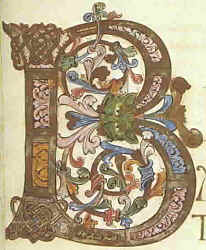
 |
|
| Figure 1. | Left: Initial 'B' from
Ramsey Psalter, MS 2904 fol 4B. Right: Initial 'B' from the scroll. |
This scroll was created on calfskin vellum, which is the same material that was used in period. In the Middle Ages, parchment shops would scrape the skins from various animals, soak them in water and lye, stretch them across wooden frames and continue scraping and drying the skins until they were smooth and thin. Calfskin is considered the highest quality of parchment, and the term "vellum" specifically refers to calfskin parchments.
The high quality, white calfskin vellum used for this scroll was purchased pre-cut and pre-prepared. A mixture of pumice powder and sandarac was rubbed over the surface. This helped remove any remaining grease on the surface and its abrasive action raised the nap of the skin to help ink and paint adhere. Being my first attempt at using real vellum, I don't believe I was vigorous enough in the preparation since the ink did not flow very well over the surface.
The Ramsey Psalter is considered one of the important calligraphic works of the period, demonstrating the English Carolingian hand, and was my exemplar for this scroll. English Carolingian is distinguished from the original French Carolingian hand by the difference in serifs, and became the Foundational hand of modern calligraphy when chosen by Edward Johnston at the beginning of the 20th century.
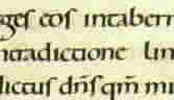
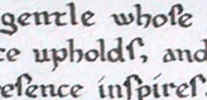 |
|
| Figure 2. | Left: English
Carolingian Calligraphy from the Ramsey Psalter. Right: Calligraphy from the scroll. |
The calligraphy was done with my smallest metal-nib pen (Mitchell #6 nib), dipped into permanent black ink. In period, cut quill feather pens (usually from a goose) would have been used, dipped into an iron gall ink. Quill pens required sharpening very often, especially to form the small letters used on this scroll. Metal-nib pens have been used for many centuries, and the technique of using a metal-nib dip pen is almost identical to that required for a quill pen.
Guide lines were drawn in pen on tracing paper and placed behind the vellum on a light table, rather than scribing guidelines into the vellum itself. In period, guidelines would have been scribed into the surface of the vellum with a sharpened stylus, leaving permanent marks. I wanted to maintain a cleaner appearance for this particular scroll. Marking directly on the scroll with pencil was also not an ideal choice as pencil lines do not erase well on vellum, therefore I chose to use the light table. Perhaps because of the inadequate preparation of the surface mentioned earlier, the calligraphy on this scroll was quite difficult. The ink did not adhere very well to the vellum, and the slick surface made it difficult to control the pen and the amount of ink flowing from the pen. Often, when making multiple strokes for a letter, the second stroke would cut through the ink of the first stroke, leaving a gap. This was highly visible when using the light table, but fortunately does not show much when looking at the scroll in normal light.
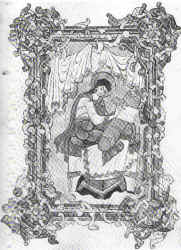 |
During the Romanesque period, borders began using more natural forms, such as acanthus leaves and vines. An 11th century Gospel from Normandy (Figure 3) is one of the earliest examples showing acanthus leaves wrapping around a border three-dimensionally. This black-and-white photograph inspired the border design of my scroll. I retained the simple shading of the leaves shown in this example, but used a color palette more compatible with the Ramsey Psalter. Romanesque manuscript illumination shows the beginnings of detailed shading, with highlights and shadows producing an appearance of three-dimensional modeling. This trend in painting acanthus leaves was not fully developed until the 14th and 15th centuries, when the shading became quite intricate and realistic. The acanthus leaves in the scroll turned out more "Gothic" than I would have liked. I should have rounded the leaves more instead of making them so pointed. |
| Figure 3: Les Preaux Gospels, MS 11850, fol 91b, Normandy 11th century. | |
Romanesque Psalters are the first manuscripts to begin using miniatures extensively. These miniatures were characterized by simple faces and figures with limited shading, compared with the more realistic shading and perspectives of later periods. Three miniatures, showing Mistress Tatiana as a Herald, Cook, and Scribe, were integrated into the gold and acanthus leaf border. These miniatures are original compositions, but were designed to reflect the simple form and shading of the Romanesque period. The reds, blues, and greens are all common period colors and shades. Purple was used to reflect the colors of the recipient's Arms and was also used in period illuminations.
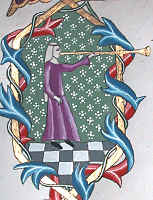
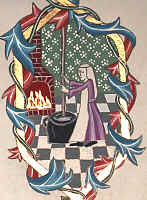
 |
|
| Figure 4. | The three miniatures on the scroll: Herald, Cook, Scribe. |
Paints were made in the Middle Ages by dissolving various pigments into a binder, such as gum arabic or egg yolk. However, many of these pigments were highly toxic. For example, red paint contained lead or iron. Yellow was made from orpiment, which contained arsenic oxide. Verdigris green contained copper and strong vinegar, or malachite. Because of the toxic nature of these pigments, modern gouache was used, and applied with small brushes. Although the actual chemicals are different and safer, gouache still consists of finely powdered pigments mixed with a binding agent.
Shading was done with white gouache, diluted in water. The diluted white "wash" was blended into the base color using a brush with water. A thicker white gouache was then used for the veins of the leaves and other highlights.
Gold leaf was extensively used during the Romanesque period. I used a liberal amount in this scroll, completing the initial 'B' as it was done in the Ramsey Psalter, and then intertwining the two ribbons of gold with the full acanthus leaf border. Gold leaf was also used to highlight elements of the miniatures, such as the golden trumpet, flames, and quill, and was used in the badge of the order and the recipient's arms in the four corners of the scroll.
In period, gold leaf would have been laid over a base made of slaked plaster, sugar, hide glue (or fish glue) and white lead. In the dry climate of Colorado, such a mixture does not work well, so a modern substitute of acrylic gloss medium (sometimes called Hyplar) was used instead. Blowing gently on the dried acrylic size makes it tacky, and gold leaf is carefully laid over the surface and burnished until shiny.
I've used gold leaf several times in the past, but had more of a problem applying it to the calfskin vellum surface for this scroll. In retrospect, the acrylic size was applied too thin, causing the gold leaf to show all of the brush marks. In the future, applying a second coat of size to build up a smoother surface would work better.
Once the gold leaf, painting, and white shading was complete, a fine metal crow quill dip pen was used to outline the entire design. This pen was also used for the details in the miniatures, such as the face and hands. In period, an actual crow quill pen would have been used for it's small size and stiffness. The metal crow quill pen simulates the period crow quill almost perfectly, without the need for constant sharpening.
Unlike later Gothic manuscripts where there was a tendency to fill all white space in the text with line fillers, and to fill borders with "motes", flowers, and various line work, Romanesque scrolls were sparse and clean. I followed that style with this scroll and kept both the calligraphy and the border clean and free from additional decoration.
The Guardian of the Golden Flame is the Barony of Dragonsspine's equivalent of the Outlands' Walker of the Way award. A month after I began work on this scroll, I was asked by the recipient to become her apprentice. Because of the special nature of this award, and the special nature of the recipient, I wanted to attempt the most detailed and period scroll that I was capable of. I'm very happy with the results. While the vellum added some unforeseen complications to the project, the end result was well worth the trouble. And there was nothing better than seeing the look on the recipient's face when she saw the scroll. Given all of the skills and knowledge that she has taught me over my first year as a scribe, it was an pleasure to produce this work to honor her.